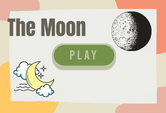The Moon Facts Game Quiz Online
This page contains The Moon Facts Game Quiz Online. The moon orbits the Earth. Most people think the moon is a planet or that the moon has a source of light. These are misconceptions; the moon is not a planet and does not produce light. The fact that it shines is only a reflection of sunlight. It is a test for students studying science in 3rd, 4th, 5th, 6th to 8th grades. Students will learn a lot more about the moon by answering 15 multiple choice questions.

Facts About the Moon You Might Not Know
There are many Facts About the Moon that you might be surprised to learn about. The Moon is Earth's only natural satellite, a quarter the diameter of the Earth. It is the fifth largest satellite in the Solar System, the largest relative to a major planet, and is larger than any known dwarf planet. In this article, we'll look at some of the most interesting facts about the moon, such as its size, gravity, and craters.
Facts about the moon phases
The Moon undergoes gradual changes in phases every month. Each lunar phase changes shape gradually over the course of a synodic month, as the Moon orbits the Earth. In other words, the Moon's phase changes shape according to how much sunlight it receives. You can learn more about the moon's phases by viewing a live stream of lunar eclipses, or by reading about the phases on a website. Regardless of how you learn about the moon phases, you'll be able to enjoy observing them from any part of the world.
If you want to learn more about the Moon, visit NASA's Space Telescope Education Program. Other websites to learn about the phases of the moon are ESA Kids and National Geographic. Learn about the moon's origin and how the different phases can affect our daily lives.
Facts about the moon landing in 1969
The astronauts returned to Earth after the moon landing on July 24, falling down into the Pacific Ocean. In order to prevent contamination, the astronauts discarded much of their luggage, but did bring back symbols of humanity. These astronauts left behind an autographed photo and a small silicon disc bearing messages of good will from 73 world leaders. In addition, the astronauts left behind recordings in several languages.
The historic event was widely covered by news organizations and created an atmosphere of public anticipation. The media covered the mission extensively, and an estimated 53 million households worldwide tuned in to watch the event. In addition, the Apollo 11 mission involved three astronauts and only two of them stepped on the moon. A plaque was also left on the moon stating that men from Earth first stepped on the moon in July 1969.
Facts about the moon's craters
Despite the fact that the Moon's surface is covered with millions of impact craters, its thin atmosphere has limited its degradation over billions of years. This has left the lunar surface with sharp craters, which can tell scientists a lot about the formation of the solar system and planets. In addition, the thin atmosphere has also prevented erosion and geological activity on the moon, which means that the craters remain largely intact.
The moon gets hit by small pieces of outer space rock, known as comets and asteroids, which create a big impact. This impact can cause a lunar crater as small as a pea-sized rock. The size of the crater depends on the amount of energy that was generated by the rock that hit the moon. In many cases, the crater on the Moon is larger than the size of the rock that caused it to crash.
Facts about the moon's gravity
Did you know that the Moon's gravity is one sixth of Earth's? Considering that the moon is so much smaller than Earth, the force of gravity it exerts on objects is relatively small. As a result, standing on the surface of the Moon would result in only 17% of Earth's gravity. This is incredible news for astronauts, but it also means that a moon mission will likely be a lot harder than we thought!
The moon's egg shape is caused by Earth's gravitational pull. The Moon was formed due to Earth's gravitational pull on the young moon during its formation. Even today, the moon's shape changes due to the lunar body tide, which creates bulges on the surface and a matching lump on the opposite side.
